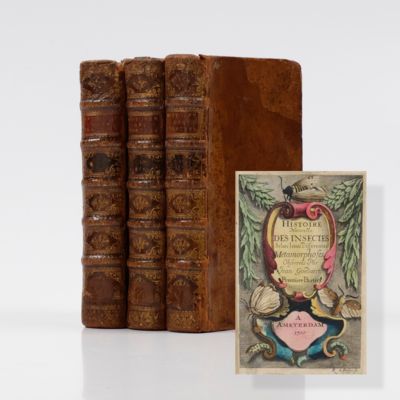Goedart, J. [Goedaert]
Metamorphoses naturelles ou histoire des insectes observée tres-exactement suivant leur nature & leurs propriétéz. Avec les figures en taille-douce gravées d'aprés nature.
Amsterdam, Pierre Mortier, 1700. Three volumes in three. 12mo (15.4 x 9.1 cm). Engraved title " Histoire naturelle des insectes selon leurs differentes metamorphoses observées par Jean Goedaert"; frontis portrait of the author; letterpress title. 770 pp. ([viii], 238; 254; 270); 127 [64, 42, 21] engraved plates, all in fine, contemporary hand-colouring. Uniform contemporary full polished mottled calf. Spines with five raised, gilt-ornamented bands; compartments rich gilt with gilt floral vignettes and corner-pieces. Burgundy morocco labels with gilt ornamental borders and title, and ditto black labels with volume number. Gilt floral dentelles. Marbled edges.
A rare, contemporarily coloured complete set of the first French edition of Goedaert's famous work on insects and their transformations, with engraved plates by the author. The work became very popular and was translated into English in 1682 and into French in 1700. The author, Johannes Goedaert (1617-1668) was a painter and entomologist. He raised maggots and larvae all his life and described and depicted in detail what he observed. Goedaert was the first to describe the metamorphosis of insects, and gave many species a Dutch name. With his publications in words and images he promoted interest in insects and gave the impetus to further research. In the title, the author emphasizes that all were based on personal observations and none copied from other books, which, for the mid-17th century, is revolutionary indeed. Thus, Goedaert created his own "school"; one of the most famous naturalists to set forth Goedaert's method was Maria Sibylle Merian. From the age of 18, Goedaert himself documented his observations not only in words, but also in images. Goedaert, a "Fijnschilder" (master painter) and member of the Guild of Saint Luke, made watercolour drawings of the changes in the animals he cared for: drawings of the maggots, which became a pupa and a fly, and of the caterpillars, which became a pupa and a butterfly, or a whole swarm of "flies". Goedaert had no university education and no knowledge of Latin, but Jan Swammerdam acknowledges in his Historia Insectorum Generalis (1669) that Goedaert has described more about insects than all scholars in all the centuries before him put together. In the third volume, the second plate numbered N, is actually Plate Z, and should be placed after Plate Y. Old, small label on each spine foot, and another on the front pastedowns. Text leaves toned, as usual, mostly very lightly, but a few sections, as well as the endpapers, more strongly. All plates, except two, are much cleaner; Plates X and Z are mildly toned. Small worm traces in the margin of the first four signatures of Vol. II, otherwise a very good, attractive, clean set. Hagen I, p. 289; Horn-Schenkling, II, p. 435; Landwehr, 64 (Dutch edition); Nissen ZBI, 1603.




